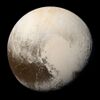Astronomy:2010 JO179
| Discovery [1][2] | |
|---|---|
| Discovered by | Pan-STARRS 1 |
| Discovery site | Haleakala Obs. |
| Discovery date | 10 May 2010 (first observed only) |
| Designations | |
| 2010 JO179 | |
| Minor planet category | TNO [3] · 5:21 res [4] SDO [5][6] · distant [1] p-DP [7] |
| Orbital characteristics [3] | |
| Epoch 31 May 2020 (JD 2459000.5) | |
| Uncertainty parameter 2 | |
| Observation arc | 69.54 yr (25,399 days) |
| Earliest precovery date | 4 February 1951 (POSS-I)[1] |
| |{{{apsis}}}|helion}} | 117.997 AU |
| |{{{apsis}}}|helion}} | 39.590 AU |
| 78.793 AU | |
| Eccentricity | 0.49755 |
| Orbital period | 699.43 yr (255,466 d) |
| Mean anomaly | 35.211° |
| Mean motion | 0° 0m 5.04s / day[3] |
| Inclination | 32.025° |
| Longitude of ascending node | 147.350° |
| |{{{apsis}}}|helion}} | 1951-Sep-12 |
| 10.427° | |
| Physical characteristics | |
| Mean diameter | 597 km[7] 735 km[5] 600–900 km[4] |
| Rotation period | 30.6 h[4] 30.6324 h (best fit)[4] |
| Geometric albedo | 0.07 ~ 0.21 (estimated)[4] 0.10 (assumed)[7] 0.09 (assumed)[5] |
| G–R = 0.88±0.21 (red)[4] | |
| Absolute magnitude (H) | 3.44±0.10 (R-band)[4] 4.0[3][1] 4.3 (Brown)[7] |
2010 JO179 is a high-order resonant trans-Neptunian object and a likely dwarf-planet candidate from the outermost regions of the Solar System, approximately 700 kilometers in diameter.[4] Long-term observations suggest that the object is in a meta-stable 5:21 resonance with Neptune.[4] Other sources classify it as a scattered disc object.[5][6]
First observation and orbit
The Minor Planet Center credits the object's first official observation on 10 May 2010 to Pan-STARRS (F51) at Haleakala Observatory, Hawaii, United States.[1][2] The observations were made by Pan-STARRS' Outer Solar System Survey.[4] There are 4 February 1951 precovery images from the Palomar Observatory Sky Survey, extending the observation arc by approximately 60 years.[1] The precovery images are from the same year the object came to perihelion (closest approach to the Sun).
2010 JO179 orbits the Sun at a distance of 39.6–118 AU once every 699 years and 5 months (semi-major axis of 78.8 AU). Its orbit has a high eccentricity of 0.50 and an inclination of 32° with respect to the ecliptic.[3]
Physical characteristics
Photometry
Photometric observations of 2010 JO179 gave a monomodal lightcurve with slow rotation period of 30.6 hours, suggesting a rather spherical shape with significant albedo patchiness. An alternative period solution of a bimodal lightcurve is considered less likely. It would double the period and imply an ellipsoidal shape with an axis-ratio of at least 1.58.[4]
Diameter and albedo
The object's mean diameter has been estimated to measure 574 and 735 kilometers, with an assumed albedo of 0.09, by Michael Brown and the Johnston's Archive respectively,[5][7] while the discoverers estimate a diameter of 600–900 kilometers with an estimated albedo of 0.21 to 0.07.[4] In his classification scheme, astronomer Michael Brown considers this object a likely dwarf planet, rather than a "highly likely" one, as his diameter-estimate is below the 600-kilometer mark.[7]
Numbering and naming
As of 2018, this minor planet has not been numbered or named.[1]
References
- ↑ 1.0 1.1 1.2 1.3 1.4 1.5 1.6 "2010 JO179". Minor Planet Center. http://www.minorplanetcenter.net/db_search/show_object?object_id=2010+JO179. Retrieved 27 August 2020.
- ↑ 2.0 2.1 "MPEC 2017-S54 : 2010 JO179". Minor Planet Center. 18 September 2017. https://minorplanetcenter.net/mpec/K17/K17S54.html. Retrieved 21 February 2018.
- ↑ 3.0 3.1 3.2 3.3 3.4 "JPL Small-Body Database Browser: (2010 JO179)". Jet Propulsion Laboratory. https://ssd.jpl.nasa.gov/sbdb.cgi?sstr=3781468. Retrieved 28 August 2020.
- ↑ 4.00 4.01 4.02 4.03 4.04 4.05 4.06 4.07 4.08 4.09 4.10 4.11 Holman, Matthew J.; Payne, Matthew J.; Fraser, Wesley; Lacerda, Pedro; Bannister, Michele T.; Lackner, Michael et al. (2018). "A dwarf planet class object in the 21:5 resonance with Neptune". The Astrophysical Journal 855 (1): L6. doi:10.3847/2041-8213/aaadb3. Bibcode: 2018ApJ...855L...6H.
- ↑ 5.0 5.1 5.2 5.3 5.4 Johnston, Wm. Robert (15 October 2017). "List of Known Trans-Neptunian Objects". Johnston's Archive. http://www.johnstonsarchive.net/astro/tnoslist.html. Retrieved 15 December 2017.
- ↑ 6.0 6.1 "List Of Centaurs and Scattered-Disk Objects". Minor Planet Center. http://www.minorplanetcenter.org/iau/lists/Centaurs.html. Retrieved 15 December 2017.
- ↑ 7.0 7.1 7.2 7.3 7.4 7.5 Michael E. Brown. "How many dwarf planets are there in the outer solar system?". California Institute of Technology. http://web.gps.caltech.edu/~mbrown/dps.html. Retrieved 15 December 2017.
External links
- MPEC, 18 September 2017
- 2010 JO179 at AstDyS-2, Asteroids—Dynamic Site
- 2010 JO179 at the JPL Small-Body Database




